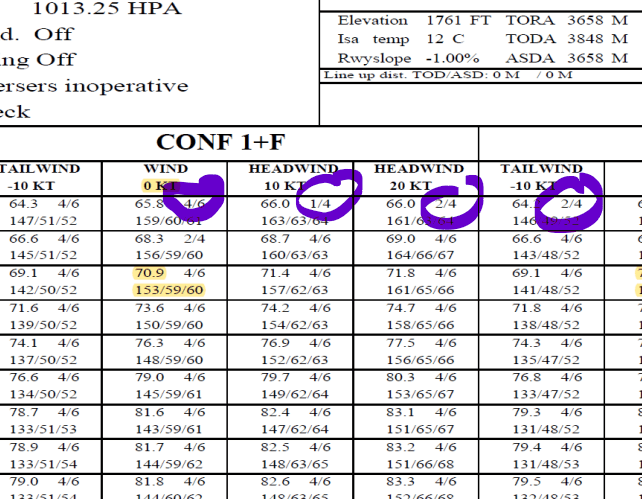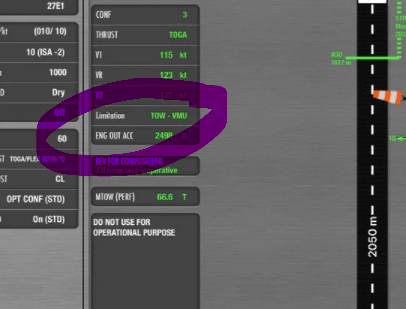RTOW charts are computed for each runway using approved Airbus performance software called Performance Engineering Program (PEP). They optimize takeoff performance and aim at obtaining maximum performance limited takeoff weight or optimum takeoff thrust for a given weight. The following parameters can be optimized:
- Aerodynamic Configuration (selection of flaps)
- Air conditioning (Packs On or Off takeoff)
- Thrust setting (TOGA/FLEX/Derated levels)
- Takeoff speeds (This has largest effect on the gain of takeoff weight. The range of optimization varies from 0.84 to 1.0 for V1/VR ratio and from 1.13 to 1.4 for V2/VS1G ratio)
TREF |
TMAX |
TVMC |
| TREF – Flat-rated temperature, indicated at the bottom of the RTOW chart, varies with pressure altitude. You will find different values at different RTOW charts. Flat-rate thrust remains consistent up to TREF. Below TREF, thrust is limited by pressure constraints, while above TREF, it is limited by EGT (exhaust gas temperature) restrictions. | TMAX represents the maximum temperature permissible for flight operations, also provided on the RTOW chart.
(Maximum certified temperature for takeoff) |
TVMC is a hypothetical value indicating temperature where speeds are close to Vmcg/Vmca limits. Corrections are applied based on whether OAT (outside air temperature) or Flex (for flex temperature calculation) is less than TVMC or more. RTOW charts line 1 and line 2 corrections are used when OAT/FLEX is less than TVMC and line 3 and line 4 when OAT/FLEX is more than TVMC. |
T FLEX MAX
TFLEX MAX is temperature at which maximum thrust reduction allowed by regulation is reached.
For most of the MSN numbers flex takeoff with maximum thrust reduction of 25% is allowed (with few exceptions where 40% thrust reduction is also allowed).
GREY BAR
A grey bar signifies that the takeoff speed is approaching the Vmca limit. V1 is constrained by Vmcg, while V2 is constrained by Vmca. This indication is given so that the pilot pays particular attention to the aircraft control at these low speeds.
GRAD CORRECTION
GRAD Correction is applicable when OAT is below the flex temperature specified with maximum weight. Grad 1 applies when the temperature is less than TREF, and Grad 2 applies when the temperature is higher. Maximum thrust begins to decrease during Grad 2. It is applied only when OAT is less than flex temperature mentioned with maximum weight. This is generally used to find out MTOW. Speeds remain same after Grad 1 and Grad 2 corrections to weight.
DRY CHECK
A dry check involves comparing weights to those on a wet runway, as wet conditions may allow for higher weights due to reduced screen height (15 feet) and credit for reversers. To avoid this situation, lower weight is taken for all TOW references.
Additional Notes:
- As per regulations, Takeoff performance is calculated without considering the benefit of thrust reversers.
- Effect of thrust reversers may be considered for WET and CONTAMINATED runway but in doing so no MTOW cannot be higher than calculated DRY runway.
- All performance data is given on concept of balanced field length.
RTOW FAQs
Reference: https://www.scribd.com/presentation/379851293/Webconference-01-Rtolw-Faq-Takeoff
- What is the Airbus philosophy for operation with A320 on runways with width less than 45 meters?
Operating on a runway with a width lower than 45 m implies an increase in Vmcg to control aircraft. This is automatically taken care by software as long as runway width has been correctly entered. - With T MAX FLEX of ISA+75, thrust will go below 25% of maximum legal thrust reduction. Is this allowed?
New certification from authorities has been obtained. It was a regular practice by other manufacturer to go beyond 25% using flex or derate. - How to calculate minimum and maximum acceleration altitude for go-around with engine out?
There is no minimum and maximum acceleration altitude definition for go-around. Only climb gradients need to be met. - For the same conditions, if there is the same TOW for CONF 2 and CONF 3, which one is more favorable?
Use the configuration that gives the highest flex. If both of them provide same flex, use the one with the highest flaps setting.
Limitations display of RTOW charts
Nature of takeoff weight limitation is always indicated in takeoff charts (RTOW charts). Following is the list of codes assigned to different limitations.

| Limitations Codes | |
| OCTOPUS codes A320/A330/A340 | |
| Codes | Nature |
| 1 | 1st segment |
| 2 | 2nd segment |
| 3 | Runway OEI and AEO |
| 4 | Obstacle |
| 5 | Tire Speed |
| 6 | Brake Energy |
| 7 | Structural Weight |
| 8 | Final takeoff |
| 9 | Vmu |
- OEI – One Engine Inoperative
- AEO – All Engine Operative
Limitations display on EFB program
In EFB Airbus is using Flysmart+ program for take-off and other performance calculations. Limitation codes are not application to this as same is displayed in textual format.
